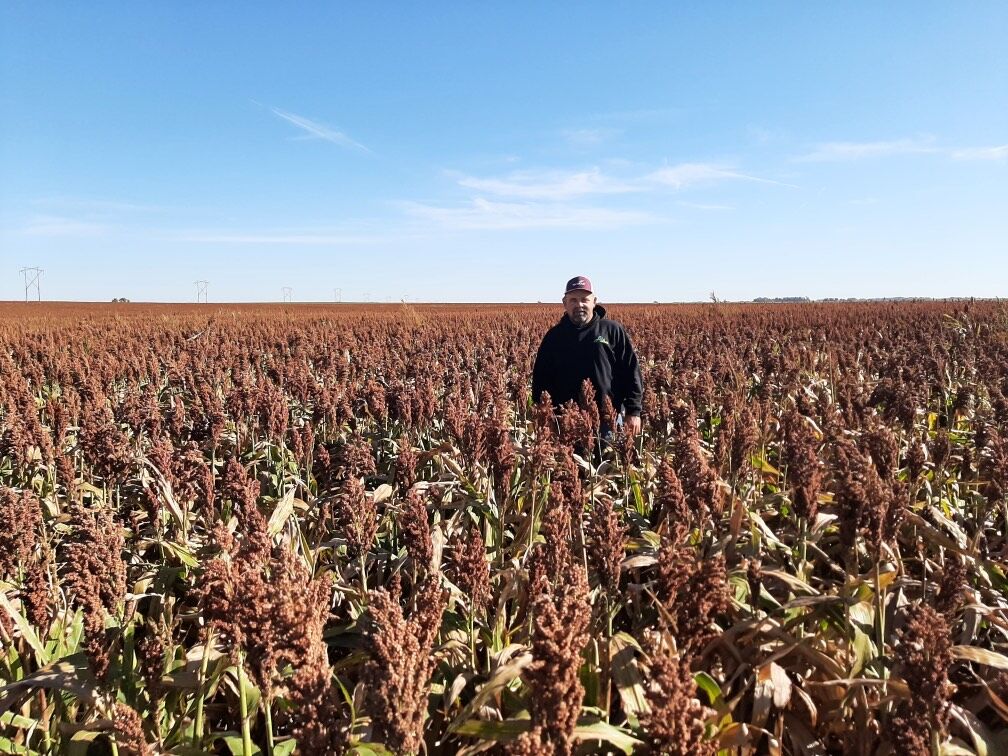The wait is over. Over-the-top control of grassy weeds is finally here for farmers in the nation’s Sorghum Belt.
And early results amid the crop’s first commercial season are promising.
Alta Seed’s igrowth trait represents the most significant advancement in sorghum since hybridization. The non-genetically modified trait is tolerant to imidazolinone herbicide for pre- or post-emergence weed management without damaging the crop.
The igrowth technology was adopted on about a half-million acres this year and will be widely available in 2022. Charlie Haas, a Larned, Kansas-area farmer who is one of Alta Seed’s largest distributors, said farmers are excited about new sorghum technology. Last spring, he sold out of the more than 2,000 bags he had available.
Cleaner fields mean a more profitable harvest, Haas said. On his own farm, the igrowth trait allows him to plant sorghum in places he hasn’t been able to for years.
“Everyone has been really happy with what they’ve seen so far,” said Haas, adding he expects acres to increase with the release of more varieties next year. “This is going to give us a lot of weed control options that we didn’t have before.”
Companion chemistry
The igrowth production system includes a companion herbicide, IMIFLEX, which received Environmental Protection Agency approval last December. IMIFLEX was developed by global crop protection company UPL—a—is the only imidazolinone herbicide labeled for use with the igrowth system.
Haas said he previously tried to reduce weeds in sorghum by layering pre-emergent herbicide applications with a regimented crop rotation, but even that wasn’t a perfect solution with herbicide-resistant species. In extreme cases, he has tilled fields that had been no-till for years. In other areas, he was forced to remove sorghum out of the rotation.
“My goal was to keep the weeds from coming up,” Haas said. “But once we planted, we didn’t have any options to put on the milo. Now IMIFLEX has really helped me stretch my residual window.”
Utilizing IMIFLEX with igrowth sorghums, along with his traditional pre-emergent herbicides program, gives him another layer in his residual herbicide management plan.
Haas started his herbicide schedule by adding atrazine to his sorghum fields in February, followed by a mix of other chemistry, such as Callisto. Acetochlor or S-metolachlor and atrazine were applied at planting. About 15 to 25 days after the crop’s emergence, he applied IMIFLEX.
Haas walked many of his growers’ fields this summer and saw positive results. IMIFLEX has helped control troublesome grasses, including crabgrass and foxtail species. It also worked well as a residual to help suppress broadleaves.
Haas stressed producers need to use proper stewardship when using the igrowth system. For instance, farmers should follow label application recommendations and implement crop rotations.
“We saw better results when farmers followed the recommended tank mixes and didn’t cut corners,” he said.
Haas added the technology even helped him manage volunteer corn.
"There hasn’t been a good way to deal with volunteer corn that is Roundup resistance. But with IMIFLEX, I was able to clean up all my volunteer corn in my sorghum fields.”
Game changer
For years, water-sipping sorghum has had a hard time gaining ground on the High Plains. There hadn’t been as much head-turning innovation or money sunk into sorghum hybrids—putting it lightyears behind corn and soybeans in terms of research and development, Haas said.
Now that’s finally changing, he said. With the Ogallala Aquifer continuing to diminish—threatening the economy centered around it—the igrowth system could change the landscape of semi-arid western Kansas where water-hungry corn has been king.
“We saw acres go into milo this year that haven’t been planted to milo for years because of this technology,” he said. "In the past, weed pressure didn’t allow them to plant those fields to sorghum."
Haas said he is eager to see how year two develops.
“The (sorghum) basis isn’t as advantageous as it was last year, but when you are talking milo versus corn, we are a lot drier in a lot of places than we have been in years," he said. "That makes grain sorghum a much better crop for us.”
Three new igrowth hybrids will be commercialized for 2022, with a total of five available. These new varieties will be even better yielding and more adaptable to stress, Haas said.
Research and analysis of this year’s plot data will continue to improve the technology. For instance, Haas is hopeful for the development of a shorter-season hybrid for later planting or as a double crop.
“We’re right in the middle of harvest, and we are excited to see how it will yield compared to other varieties and what varieties will stand out," he said. "We’ll know so much more, especially once we have our plot data from this year’s harvest."
There are no absolutes when it comes to weed control, Haas stressed. But the breakthrough igrowth technology will be a gamechanger for sorghum states like Kansas.
“It’s not a silver bullet, but it’s working,” he said. “It’s another tool in the toolbox. And if we manage it correctly, it is going to help us.”
Amy Bickel can be reached at [email protected].




